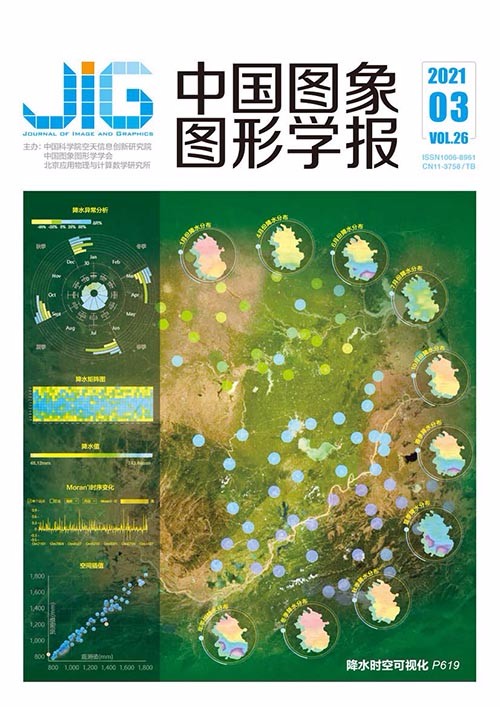
自适应B样条小波函数模糊距离测量方法
摘 要
目的 双目测距和单目测距是目前常用的两种基于光学传感器的测距方法,双目测距需要相机标定和图像配准,计算量大且测量范围有限,而单目测距减少了对设备和场地的要求,加快了计算时间。为了解决现有的单目测距方法存在精度低、鲁棒性差等缺点,本文提出了一种基于单模糊图像和B样条小波变换的自适应距离测量方法。方法 引入拉普拉斯算子量化评估图像模糊程度,并根据模糊程度值自动定位阶跃边缘;利用B样条小波变换代替高斯滤波器主动模糊化目标图像,并通过分析图像模糊程度、模糊次数以及测量误差之间的关系模型,自适应地计算不同景物图像的最优模糊次数;根据最优模糊图像中阶跃边缘两侧模糊程度变化求解目标边缘和相机之间的相对距离。结果 本文方法与基于高斯模糊图像的距离测量方法相比精度更高,平均相对误差降低5%。使用不同模糊次数对同样的图像进行距离测量时,本文算法能够自适应选取最优模糊次数,保证所测量距离的精度更高。结论 本文提出的单视觉测距方法,综合了传统的方法和B样条小波的优点,测距结果更准确,自适应性和鲁棒性更高。
关键词
Adaptive distance measurement method with blur of B-spline wavelet function
Liang Rui, Wei Yangjie(School of Computer Science and Engineering, Northeastern University, Shenyang 110004, China) Abstract
Objective In the robot's path planning and obstacle avoidance process, measuring the relative distance between the target and the sensor is very important. Distance measurement methods based on optical sensors have the advantages of portability, intuitiveness, and low cost. Therefore, they are widely used in real applications. Visual distance measurement methods commonly include monocular visual measurement and binocular visual measurement. There are two main methods for binocular image measurement:estimating the distance between the target and the camera by comparing two blurred images with different optical parameters or measuring the distance by comparing the parallax maps of these two images. However, both methods require sufficient baseline distance between the left and right cameras. Therefore, they are not suitable for smaller installation sites (unmanned boats). Furthermore, they are computationally expensive and difficult to be used in real-time applications. Monocular vision measurement was first proposed by Pentland. The basic principle is calculating the distance between the edge in the target image and the camera through the brightness changes on both sides of the target edge. Compared with binocular vision measurement, monocular vision measurement requires only one camera, and its calculation principle is simple. However, the following problems still exist in practical applications. 1) These methods are based on the exact position evaluation of the target step edge in a single image. However, this condition is difficult to be satisfied in practical applications. Therefore, a preprocessing module for detecting edges should be added, which increases the complexity and reduces the adaptability of these methods. 2) When using the Gaussian filter to approximate the fuzzy point spread function, the problems of losing the edge of slow change and the low accuracy of edge positioning in Gaussian filtering are ignored. The positioning accuracy directly affects the accuracy of monocular measurement. 3) The blurring degree of an image is related directly to the accuracy of measurement. In spite of this, the distance measurement is performed by the method to re-blur the target image multiple times. Moreover, the quantitative relationship between the number of re-blur process and the accuracy of the distance measurement is unknown. Therefore, the distance measurement accuracy is difficult to control and improve from the perspective of active blurring. Method This study proposes an adaptive method of measuring distance on the basis of a single blurred image and the B-spline wavelet function. First, the Laplacian operator is introduced to quantitatively evaluate the blurring degree of the original image and locate the target edge automatically. According to the principle of blurring, the blurring degree of the original image increases as the number of re-blur increases. When the blurring degree reaches a certain amount, it will change more slowly until it cannot judge the change in the blurring degree caused by two adjacent re-blurs. On the other hand, as the re-blur number increases, the distance measurement accuracy first increases and then decreases rapidly when the re-blur number reaches a certain value. Therefore, the relationship among the calculated blurring degree, re-blur number, and distance measurement error is established. Then, the B-spline wavelet function is used to replace the traditional Gaussian filter to re-blur the target image actively, and the optimal re-blur number is adaptively calculated for different scene images on the basis of the relationship among the blurring degree of image, number of blurs, and measurement error. Finally, according to the change ratio of the blurring degree on both sides of the step edge in the original blurred image, the distance between the edge and the camera is calculated. Result A comparison experiment with respect to different practical images is conducted. The experimental results show that the method in this study has higher accuracy than the method of measuring distance on the basis of re-blur with the Gaussian function. Comparatively, the average relative error decreases by 5%. Furthermore, when the distance measurement is performed on the same image with different re-blur numbers, the measurement accuracy is higher with the optimal re-blur number obtained with the relationship among the blurring degree of image, number of blurs, and measurement error. Conclusion Our proposed distance measurement method combines the advantages of traditional distance measurement method with the Gaussian function and the cubic B-spline function. Owing to the advantages of B-spline in progressive optimization and the optimal re-blur number achievement method, our method has higher measurement accuracy, adaptivity, and robustness.
Keywords
monocular vision measure distance B-spline wavelet Laplace operator evaluation of the blurring degree
|



 中国图象图形学报 │ 京ICP备05080539号-4 │ 本系统由
中国图象图形学报 │ 京ICP备05080539号-4 │ 本系统由